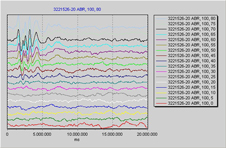Technologies
Grip strength (Bioseb, Chaville, France)
Grip force is measured to evaluate muscle function of fore paws or all paws. The device exploits the tendency of a mouse to grasp a custom-made horizontal metal grid while being pulled by its tail. The maximum force or the mouse applied before releasing the grid is measured.
Rotarod (Bioseb, Chaville, France)
The performance of mutant mice on the Rotarod provides information about motor coordination and balance as well as basic motor learning skills dependent upon the protocol used. The rotarod device is equipped with a computer controlled motor-driven rotating rod.For motor coordination testing an accelerating speed from 4 to 40 rpm for 300 sec with 15 min between each of the 3 trials is used.
Auditory Brainstem response (ABR; Tucker Davis Technologies, TDT, Alachua, FL, USA)
The ABR is an electrophysiological recording widely used for determination of hearing sensitivity, e.g. estimation of hearing thresholds for broadband click stimuli and pure tone frequencies.
The auditory stimulus generates a response from the hair cells of the cochlea and the signal travels along the auditory pathway. This response is recorded as a series of vertex positive waves which are generated by different auditory structures. In humans, ABR allows diagnosing of various otological, audiological, and neurological abnormalities and is a part universal newborn hearing screening. In mice, similar to humans, ABR is applied for evaluation of suspected retrocochlear pathology such as acoustic neuroma, vestibular schwannoma, and hearing sensitivity. The threshold, amplitude, and latency analysis of the ABR deliver information on the peripheral hearing status and the integrity of brainstem pathways (Burkard et al., 2007).

Source: GMC

NCV (Natus, Middleton, USA)

Dysfunction in the peripheral nervous system can result from aging, or disease, including diabetes. And is also associated with skeletal muscle loss and sensory disorders, depending on the nerves affected. Nerve conduction velocity (NCV), the speed at which electrical signals propagate along peripheral nerves, is commonly used to evaluate the functional status of both the neurons and the myelin sheath The action potential amplitude can also be measured, which gives insight into axonal loss. sensory (sural) and motor (sciatic) nerves in the hind limb.
Telemetric electroencephalography (Data Sciences International (DSI), St. Paul, USA)
Telemetric EEG measurements are employed for the characterization of paroxysmal disorders. Implanted electrodes allow the analysis of freely moving mice independent of anesthesia side effects.

Digigait®
Gait abnormalities are involved in a variety of human movement disorders. Several spatial and temporal parameters, but also pattern shifts and variation indices are helpful and well established criteria for diagnostic testing. Gait parameter changes are also helpful readouts for respective mouse models. Using walking tracks, a number of different gait parameters can be analysed. We use DigiGait Imaging System (Mouse Specifics, Inc.), which performs ventral plane videography to obtain digital footprints of a mouse walking on the transparent treadmill, and subsequently analyse gait patterns using DigiGait software.

Running wheels (TSE Systems, Bad Homburg, Germany)

Running wheels can be used for measuring activity as well as activity pattern during circadian rhythm, but can also be used for exercise training. The home-cage-based running-wheel system (TSE Systems, Bad Homburg, Germany) used here have conventional wheels but can also equipped with complex wheels with particular rungs absent.

